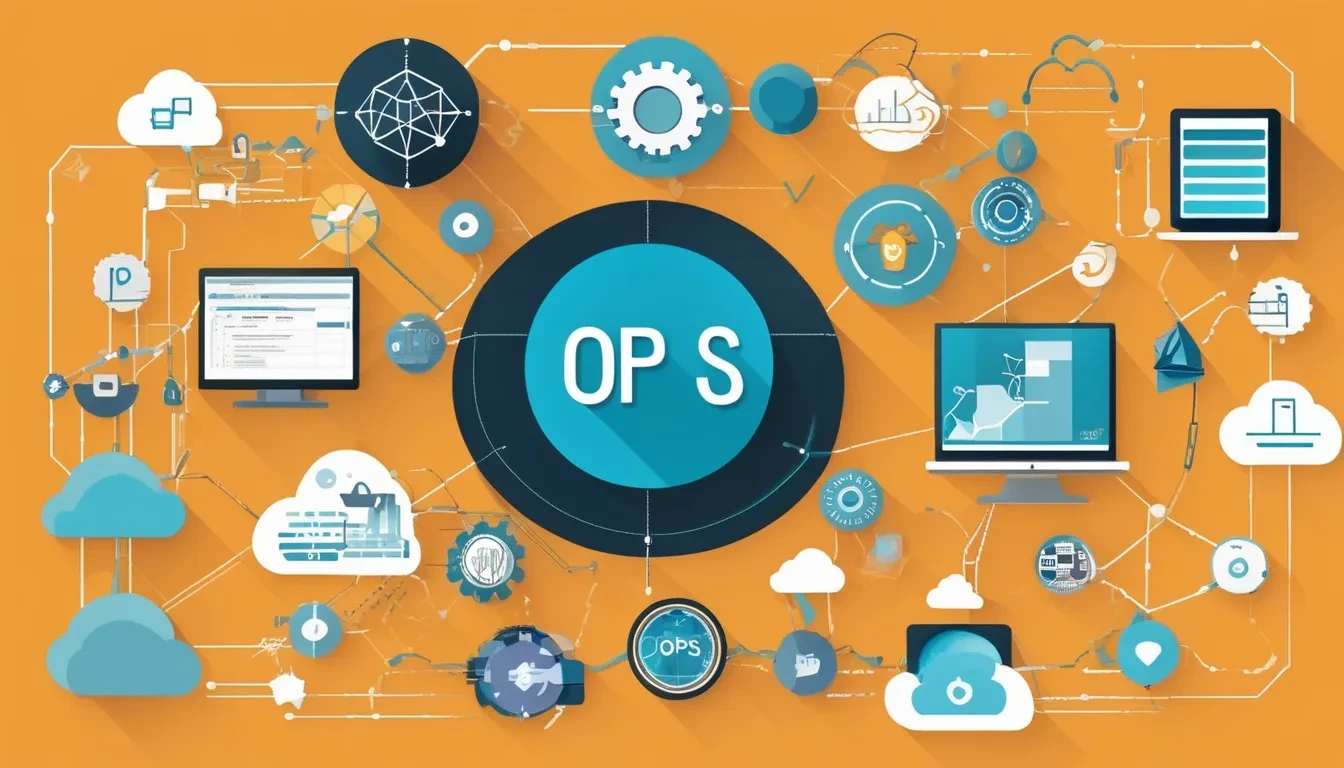
The Rise of Ops: Exploring the Trends in DevOps, SecOps, and DataOps
Introduction to the Ops Trend
In the rapidly evolving landscape of software development, the term “Ops” has gained significant traction, encompassing various methodologies that promote collaboration, efficiency, and integration across different IT disciplines. At its core, the “Ops” trend represents a paradigm shift from traditional silos to a more holistic approach in managing technology operations. This transformation has led to the emergence of key methodologies such as DevOps, SecOps, and DataOps, each of which addresses distinct yet interrelated aspects of modern software development.
DevOps, which combines development (Dev) and operations (Ops), seeks to enhance the collaboration between software developers and IT operations teams. Through the adoption of continuous integration and continuous deployment (CI/CD) practices, DevOps aims to streamline workflows, reduce time-to-market, and ultimately improve software quality. By fostering a culture of shared responsibility and cross-functional teamwork, organizations can respond more swiftly to market demands and technological changes.
On the other hand, SecOps emphasizes the integration of security practices into the operational processes. As cyber threats become increasingly sophisticated, the need for security to be part of the operational lifecycle has never been more critical. This methodology advocates for proactive security measures, ensuring that security considerations are embedded throughout the software development life cycle rather than being an afterthought.
DataOps addresses the challenges associated with data management and analytics. With the exponential growth of data, organizations require a framework that allows for agile data processing and analysis. DataOps facilitates collaboration among data engineers, data scientists, and business stakeholders, enabling them to deliver reliable data insights more efficiently.
As organizations continue to embrace these methodologies, the relevance of “Ops” in the tech industry will only deepen, paving the way for enhanced agility, security, and informed decision-making in software development practices.
Understanding DevOps
DevOps is a transformational approach that seeks to improve collaboration and integration between software development (Dev) and IT operations (Ops) teams. Its origins can be traced back to the Agile movement of the early 2000s, where the focus shifted towards responsive and iterative software development processes. Recognizing the growing need for faster deployment cycles without compromising software quality, organizations began bridging the gap between development and operations, culminating in the establishment of DevOps as a formal practice.
At its core, DevOps is built on several key principles that focus on enhancing collaboration, communication, and integration between teams traditionally operating in silos. One significant principle is the emphasis on cultural change, as it promotes shared responsibilities and cross-functional teams. This cultural shift encourages individuals from development and operations to work together throughout the entire software development lifecycle, fostering an environment where feedback can be quickly acted upon. Such cooperation not only enhances morale but also drives collective ownership of the final product.
Automation is another essential aspect of DevOps, as it enables a streamline of various processes, thereby minimizing the potential for human error and increasing efficiency. Tasks such as code integration, testing, deployment, and monitoring can all be automated, which significantly reduces the time it takes to move from development to production. This automation leads to shorter release cycles, allowing teams to deliver higher-quality software rapidly and respond adeptly to changing market demands.
Ultimately, the adoption of DevOps practices results in a more agile organization capable of deploying updates and new features more frequently. As a direct consequence, teams can respond to customer feedback and resolve issues more swiftly, ultimately enhancing customer satisfaction and fostering innovation. The rise of DevOps has irrevocably transformed how organizations approach software development and delivery, making it a critical element in the tech landscape today.
The Importance of SecOps
In the evolving landscape of software development and deployment, the integration of security practices into operations is increasingly recognized as paramount. This practice, known as SecOps, emphasizes a proactive and collaborative approach to security in the context of operational processes. Many organizations are confronted with challenges when attempting to weave security seamlessly into DevOps practices. However, the necessity for this integration has never been more critical given the rising frequency and sophistication of cyber threats.
SecOps plays a vital role in mitigating these risks, which can arise from rapid deployment cycles and lax security measures often present in traditional development settings. The fundamental challenge lies in balancing the needs for security and development speed. Security measures, if not integrated wisely, can lead to bottlenecks that may ultimately hinder an organization’s agility. Nonetheless, adopting SecOps allows organizations to cultivate a culture of security awareness, where teams understand the importance of security in their daily operations.
With SecOps, incident response can be significantly improved, as security considerations are embedded from the outset. This approach ensures that vulnerabilities are identified and addressed early in the development process, allowing teams to maintain a rapid pace without compromising on security. Moreover, fostering collaboration between security and development teams leads to a more cohesive work environment, where security is seen as a shared responsibility rather than an impediment. As a result, organizations can better defend against potential threats while still meeting business objectives and accelerating their software delivery timelines.
In conclusion, the integration of SecOps into organizational workflows serves not only to enhance security but also to ensure that security measures are harmoniously aligned with operational requirements. By prioritizing SecOps, organizations are better equipped to navigate the complexities of modern development practices while safeguarding their digital assets. This dual focus not only reinforces a robust security framework but also bolsters trust among users, stakeholders, and customers alike.
The Role of DataOps
DataOps, a disciplined approach to managing data and analytics processes, is increasingly important in the contemporary data-driven landscape. By applying DevOps principles to data management, DataOps aims to improve the velocity, quality, and reliability of data through streamlined processes and enhanced collaboration among the various stakeholders. This methodology emphasizes the fundamental tenets of agility, continuous feedback, and integration to ensure that the flow of data is not only efficient but also effective.
Central to the success of DataOps is the collaboration between data engineers, data scientists, and analysts. These roles, while distinct, must work cohesively to ensure the integrity and availability of data. Data engineers are responsible for building and maintaining robust data pipelines, which serve as the foundation upon which data is analyzed. Simultaneously, data scientists leverage these pipelines to derive insights and create predictive models that inform strategic decisions. Analysts, on the other hand, translate these insights into actionable business intelligence. By fostering a collaborative environment where these roles interact regularly, organizations can ensure quicker iterations and more effective problem-solving.
Furthermore, DataOps emphasizes the importance of monitoring and optimizing data pipelines to enhance efficiency and reliability. This focus drives organizations to implement tools and practices that ensure real-time data accessibility and quality assurance. Automated testing and version control systems, akin to those in software development, play a pivotal role in safeguarding data integrity throughout its lifecycle. By doing so, organizations can mitigate risks and respond swiftly to changes in business requirements or data sources.
In conclusion, DataOps emerges as a critical enabler of data management, harmonizing the responsibilities of various data-centric roles while driving better business decision-making. Its principles not only align with modern DevOps practices but also pave the way for organizations to capitalize on the vast potential of their data assets.
Benefits of the Ops Paradigm
The emergence of the Ops paradigm—encompassing DevOps, SecOps, and DataOps—has transformed traditional workflows across numerous organizations. This shift has resulted in several key benefits that significantly enhance operational effectiveness. One of the primary advantages is increased collaboration among cross-functional teams. By integrating development, security, and operational practices, teams work together cohesively, sharing insights and fostering a culture of collective responsibility. This collaborative approach breaks down silos, thereby improving communication and alignment across the organization.
Another substantial benefit is improved efficiency in workflows. The Ops model advocates for automation and continuous integration, leading to streamlined processes that reduce bottlenecks and manual errors. For instance, companies implementing DevOps techniques have reported up to a 50% increase in deployment frequency, showcasing the impact of optimized workflows on productivity. Furthermore, the Ops paradigm accelerates time-to-market. By adopting practices such as continuous delivery, organizations can release new features and updates more rapidly, responding promptly to market demands and enhancing customer satisfaction.
In addition to increased collaboration and efficiency, the Ops approach significantly enhances the quality and security of software products. Continuous testing and monitoring embedded in the DevOps and SecOps practices ensure that vulnerabilities are identified and addressed proactively. According to a study by the DevOps Research and Assessment (DORA) group, organizations that embrace these practices experience 30 times lower change failure rates compared to those that do not.
Lastly, better risk management is a critical advantage of the Ops paradigm. The integration of security protocols within operational processes allows for early detection of potential risks, enabling companies to mitigate issues before they escalate. By focusing on security and compliance throughout the software lifecycle, organizations position themselves better to navigate an increasingly complex landscape of threats.
Challenges in Implementing Ops Practices
Implementing Ops practices such as DevOps, SecOps, and DataOps can be a formidable challenge for many organizations. One of the primary obstacles encountered during this transition is cultural resistance. Employees may be accustomed to traditional workflows and may perceive the adoption of new methodologies as a threat to their established routines. This resistance often stems from a lack of understanding of the benefits that these practices can provide, leading to skepticism and reluctance to adapt.
Additionally, many organizations grapple with legacy systems that are not easily compatible with modern Ops methodologies. These outdated infrastructures may hinder the seamless integration of new technologies and practices, creating a barrier to operational efficiency. Organizations must invest significant resources in either upgrading their systems or developing strategies to work around these constraints, which can detract from the overall implementation process.
Skills gaps also pose a substantial challenge. As organizations embrace Ops practices, the demand for specific skill sets, such as cloud computing knowledge and automation capabilities, increases. However, many existing employees may lack the necessary training or experience, leading to a workforce unprepared for the complexities associated with DevOps, SecOps, and DataOps. Addressing this skills gap is crucial, which may involve implementing comprehensive training programs or hiring specialized talent.
The integration of varied technologies further complicates the implementation of Ops practices. Organizations may find themselves navigating a diverse landscape of tools and platforms, often lacking the cohesive framework needed to bring these technologies together. This complexity necessitates a strategic approach to technology selection and integration, ensuring that all components work harmoniously to achieve the desired outcomes. Overcoming these challenges requires a commitment to change, investment in skill development, and a strategic approach to technology integration, ultimately enabling organizations to fully realize the potential of Ops practices.
Future Trends in Ops
As the landscape of operations in technology evolves, several emerging trends will significantly impact the future of DevOps, SecOps, and DataOps practices. A paramount trend is the integration of Artificial Intelligence (AI) and Machine Learning (ML) into operations. These advanced technologies will bolster automation capabilities, enabling teams to enhance decision-making processes, predict system failures, and optimize performance in real-time. AI-driven tools can analyze massive datasets, thus providing valuable insights that help improve operational efficiency and streamline workflow.
Another notable trend is the rise of NoOps, a paradigm shift aimed at removing the need for manual intervention in operational processes. The NoOps approach focuses on fully automating software delivery and infrastructure management, which ensures rapid deployment cycles and minimizes human error. As organizations increasingly adopt cloud-native solutions and serverless architectures, NoOps is positioned to become a pivotal trend, allowing development teams to concentrate on coding and innovation rather than operational maintenance.
Additionally, the growing importance of regulatory compliance within SecOps cannot be overlooked. Organizations are facing heightened scrutiny regarding data protection, privacy, and security standards. In response is the necessity for embedded compliance practices throughout the software development life cycle. Companies must adopt frameworks that help manage regulations efficiently while ensuring that security measures are consistently integrated into the deployment process. This convergence of compliance with SecOps heralds a future in which security and regulatory considerations become intrinsic components of the operational workflow.
In conclusion, the future of Ops is poised to be shaped by AI, the NoOps movement, and a more robust focus on regulatory compliance. These trends will redefine the methodologies and practices that govern software development and deployment, making for a more efficient, secure, and innovative technological ecosystem.
Case Studies of Successful Ops Implementations
The implementation of DevOps, SecOps, and DataOps methodologies has transformed various organizations, leading to remarkable improvements in efficiency and performance. A prominent example is Company A, a leading software development firm that faced lengthy release cycles and quality control issues. By adopting a DevOps approach, Company A introduced automated testing and continuous integration practices. The results were significant: the average release frequency increased from bi-monthly to weekly, and customer satisfaction ratings improved by 30%. This case underscores how aligning development and operations teams can expedite delivery and enhance product quality.
Similarly, Company B, a financial institution, encountered escalating security threats amidst rapid digital transformation. To address these challenges, it integrated SecOps into its existing processes. By fostering a culture of shared responsibility and implementing security measures throughout the software development lifecycle, Company B effectively reduced vulnerabilities by 40%. This integration also facilitated faster incident response times, further strengthening the organization’s security posture. The case illustrates the critical role that collaboration between development, operations, and security teams plays in safeguarding sensitive data.
Company C, a data analytics firm, faced difficulties in managing vast amounts of data and deriving actionable insights. To tackle this, it embraced DataOps methodologies that streamlined data management processes. By automating data pipelines and enhancing collaboration between data engineers and analysts, Company C achieved a 50% reduction in time required to generate reports. Furthermore, the organization experienced a 25% increase in data-driven decision-making, demonstrating the tangible benefits of applying DataOps principles. This exemplifies how a focus on data quality and process optimization can lead to significant operational improvements.
These case studies illustrate that whether through DevOps, SecOps, or DataOps, organizations can achieve substantial advancements by adopting innovative methodologies tailored to their specific challenges. The successful strategies employed by these companies provide valuable insights for other organizations endeavoring to implement similar practices, emphasizing the importance of collaboration, automation, and a culture of continuous improvement.
Getting Started with Ops Practices
Organizations seeking to implement Ops practices, whether in DevOps, SecOps, or DataOps, should begin by fostering a culture of collaboration across teams. Breaking down silos is essential; therefore, promoting open communication channels will encourage collaboration between development, security, and operational teams. This can be achieved through regular meetings, cross-functional teams, and utilizing shared platforms for project management that enhance transparency and engagement.
Training and education play a crucial role in the adoption of Ops practices. Investing in comprehensive training programs enables employees to understand the principles and tools associated with DevOps, SecOps, and DataOps. These programs should be tailored to different levels of expertise, ensuring that both newcomers and seasoned professionals gain valuable insights into best practices, methodologies, and technologies. This knowledge fosters a shared language and understanding among team members, further reinforcing a collaborative environment.
Choosing the right tools and technologies is instrumental in successful Ops implementation. Organizations should assess their specific needs and select tools that best fit their existing workflows while also being scalable. For instance, version control systems, continuous integration and deployment tools, and security automation software are vital components for enhancing efficiency and security in these integrated processes. Additionally, opting for tools that allow for seamless integration with current infrastructure can create a more cohesive and effective operating environment.
Finally, measuring success after implementing Ops practices is key to continuous improvement. Organizations should establish key performance indicators (KPIs) tailored to their specific goals, such as deployment frequency, change failure rates, and incident response times. Regularly reviewing these metrics allows teams to identify areas for further refinement and fosters a culture of accountability and ongoing enhancement within the organization. This iterative approach ensures that Ops practices evolve in alignment with the organization’s objectives and industry trends, driving forth its success.







